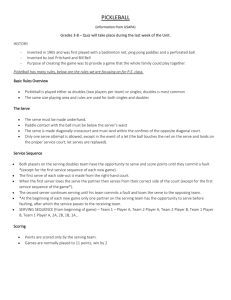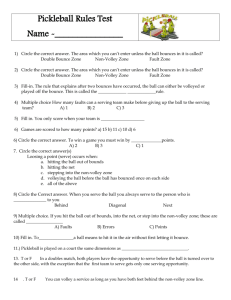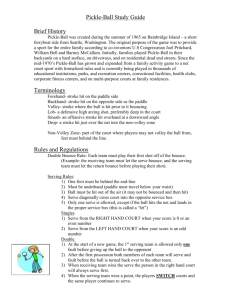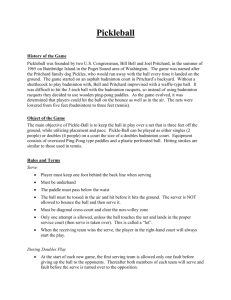Pickleball Rules-2 - Saint Joseph High School
advertisement
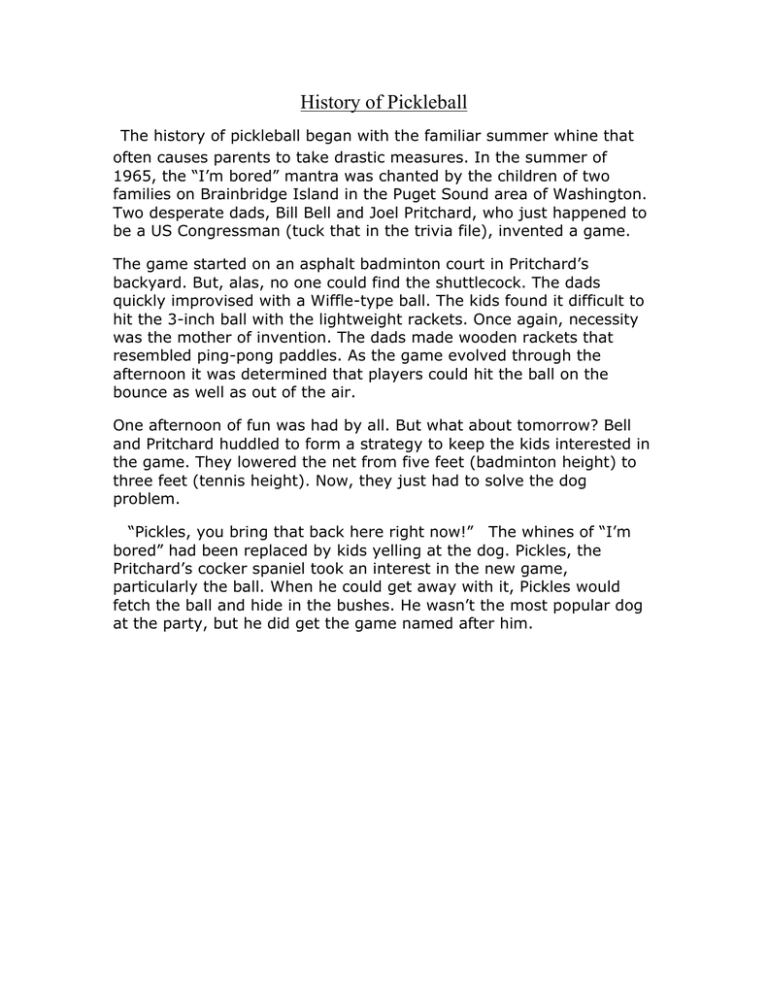
History of Pickleball The history of pickleball began with the familiar summer whine that often causes parents to take drastic measures. In the summer of 1965, the “I’m bored” mantra was chanted by the children of two families on Brainbridge Island in the Puget Sound area of Washington. Two desperate dads, Bill Bell and Joel Pritchard, who just happened to be a US Congressman (tuck that in the trivia file), invented a game. The game started on an asphalt badminton court in Pritchard’s backyard. But, alas, no one could find the shuttlecock. The dads quickly improvised with a Wiffle-type ball. The kids found it difficult to hit the 3-inch ball with the lightweight rackets. Once again, necessity was the mother of invention. The dads made wooden rackets that resembled ping-pong paddles. As the game evolved through the afternoon it was determined that players could hit the ball on the bounce as well as out of the air. One afternoon of fun was had by all. But what about tomorrow? Bell and Pritchard huddled to form a strategy to keep the kids interested in the game. They lowered the net from five feet (badminton height) to three feet (tennis height). Now, they just had to solve the dog problem. “Pickles, you bring that back here right now!” The whines of “I’m bored” had been replaced by kids yelling at the dog. Pickles, the Pritchard’s cocker spaniel took an interest in the new game, particularly the ball. When he could get away with it, Pickles would fetch the ball and hide in the bushes. He wasn’t the most popular dog at the party, but he did get the game named after him. Pickleball Rules Summary Revised: November 1, 2007. Note: This is an abbreviated form of the rules to give a quick overview of how the game is played. See the official rules at usapa.org/offficialrules for more information. If there is a conflict between this summary and the official rules, the official rules prevail. . The serve must be hit underhand and each team must play their first shot off the bounce. After the ball has bounced once on each side, then both teams can either volley the ball in the air or play it off the bounce. This is called the "double bounce rule" because the ball must hit twice (once on each side) before it can be volleyed. This eliminates the serve and volley advantage and prolongs the rallies. To volley a ball means to hit it in the air without first letting it bounce. The non-volley zone is the 7-foot zone on both sides of the net. No volleying is permitted within the non-volley zone. This rule prevents players from executing smashes from a position within the zone. When volleying the ball, the player may not step on or over the line. It is a fault if the player's momentum causes the player or anything the player is wearing or carrying to touch the non-volley zone. It is a fault even if the ball is declared dead before the player touches the zone. A player may be in the nonvolley zone at any other time. The non-volley zone is sometimes referred to as the kitchen. Both players on the serving team are allowed to serve, and a team shall score points only when serving. A game is played to eleven points and a team must win by two points. Rallies are lost by failing to return the ball in bounds to the opponent's court before the second bounce, stepping into the non-volley zone and volleying the ball, or by violating the double-bounce rule. The hand is considered an extension of the paddle. The player loses the rally if the ball hits any other part of his body or clothing. The server must keep both feet behind the baseline during the serve with at least one foot on the court surface at the time the ball is struck.. The serve is made underhand. The paddle must contact the ball below the waist. The serve is made diagonally cross court and must clear the non-volley zone. The non-volley line is a short line for the serve (the serve is a fault if it hits the line). All other lines are good at all times. Only one serve attempt is allowed, except in the event of a let (the ball touches the net on the serve, and lands on the proper service court). Let serves are replayed. At the start of each new game, only one player on the first serving team is permitted to serve and fault before giving up the ball to the opponents. Thereafter both members of each team will serve and fault before the ball is turned over to the opposing team. When the receiving team wins the serve, the player in the right hand court will always serve first. When the serving team wins a point, the server moves to the other side of the serving team's court. Note that if the serve rotation is done properly, the serving team's score will always be even when the player that started the game on the right side is on the right side and odd when that player is on the left side. Singles Play: The server serves from the right side when his score is even and from the left side when his score is odd. Rule exception: Games are usually won by two points. In some situations, event directors may choose to win by one to speed up play.
